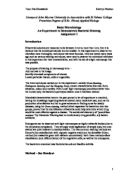What are Spore Structures in Gram +ve cells Few species of bacteria have the ability to produce highly resistant structures known as endospores
Microbiology and genetics
What are Spore Structures in Gram +ve cells
Few species of bacteria have the ability to produce highly resistant structures known as endospores (or simply spores). These resist a range of hazardous environments, and protect against heat, radiation, and desiccation. Endospores form within (hence endo-) special vegetative cells known as sporangia (singular sporangium). Diseases caused by sporing bacteria include botulism (Clostridium botulinum), gas gangrene (Clostridium perfringens), tetanus (Clostridium tetani) and acute food poisoning (Clostridium perfringens, again) All these bacteria are 'anaerobic'.
Bacterial Spores
* Function
* To permit the organism to survive during conditions of desiccation, nutrient depletion, and waste build up
What are Spore Structures in Gram +ve cells
Few species of bacteria have the ability to produce highly resistant structures known as endospores (or simply spores). These resist a range of hazardous environments, and protect against heat, radiation, and desiccation. Endospores form within (hence endo-) special vegetative cells known as sporangia (singular sporangium). Diseases caused by sporing bacteria include botulism (Clostridium botulinum), gas gangrene (Clostridium perfringens), tetanus (Clostridium tetani) and acute food poisoning (Clostridium perfringens, again) All these bacteria are 'anaerobic'.
Bacterial Spores
* Function
* To permit the organism to survive during conditions of desiccation, nutrient depletion, and waste build up







